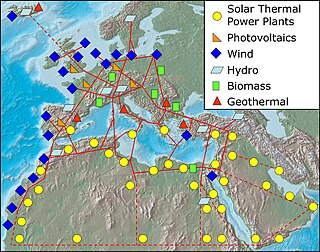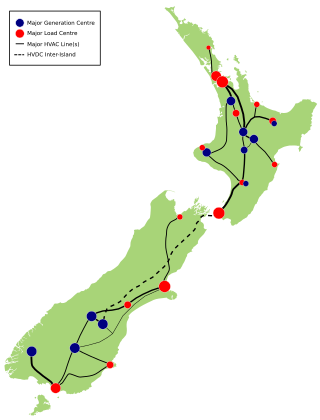Related Research Articles
Superconducting magnetic energy storage (SMES) systems store energy in the magnetic field created by the flow of direct current in a superconducting coil which has been cryogenically cooled to a temperature below its superconducting critical temperature. This use of superconducting coils to store magnetic energy was invented by M. Ferrier in 1970.

Electric power transmission is the bulk movement of electrical energy from a generating site, such as a power plant, to an electrical substation. The interconnected lines that facilitate this movement form a transmission network. This is distinct from the local wiring between high-voltage substations and customers, which is typically referred to as electric power distribution. The combined transmission and distribution network is part of electricity delivery, known as the electrical grid.

A high-voltage direct current (HVDC) electric power transmission system uses direct current (DC) for electric power transmission, in contrast with the more common alternating current (AC) transmission systems.
Technological applications of superconductivity include:
The HVDC Inter-Island link is a 610 km (380 mi) long, 1200 MW high-voltage direct current (HVDC) transmission system connecting the electricity networks of the North Island and South Island of New Zealand together. It is commonly referred to as the Cook Strait cable in the media and in press releases, although the link is much longer than its Cook Strait section. The link is owned and operated by state-owned transmission company Transpower New Zealand.

The National Grid is the high-voltage electric power transmission network serving Great Britain, connecting power stations and major substations, and ensuring that electricity generated anywhere on the grid can be used to satisfy demand elsewhere. The network serves the majority of Great Britain and some of the surrounding islands. It does not cover Northern Ireland, which is part of the Irish single electricity market.
The Cross-Sound Cable is a 25-mile long bipolar high-voltage direct current (HVDC) submarine power cable between New Haven, Connecticut and Shoreham, on Long Island, in New York, United States.

A submarine power cable is a transmission cable for carrying electric power below the surface of the water. These are called "submarine" because they usually carry electric power beneath salt water but it is also possible to use submarine power cables beneath fresh water. Examples of the latter exist that connect the mainland with large islands in the St. Lawrence River.

Long Island Power Authority is a municipal subdivision of the State of New York that owns the electric transmission and electric distribution system serving all of Long Island and a portion of New York City known as the Rockaways. LIPA was originally created under the Long Island Power Act of 1985 to acquire the Long Island Lighting Company (LILCO)'s electric and natural gas infrastructure after the cancellation of the Shoreham Nuclear Power Plant. LIPA acquired LILCO's transmission system in May 1998, while the remainder of LILCO's natural gas-related infrastructure merged with Brooklyn Union Gas to form KeySpan Energy.
American Superconductor (AMSC) is an American energy technologies company headquartered in Ayer, Massachusetts. The firm specializes in using superconductors for the development of diverse power systems, including but not limited to superconducting wire. Moreover, AMSC employs superconductors in the construction of ship protection systems. The company has a subsidiary, AMSC Windtec, located in Klagenfurt, Austria.
In lossless power transmission, a supergrid with hydrogen is an idea for combining very long distance electric power transmission with liquid hydrogen distribution, to achieve superconductivity in the cables. The hydrogen is both a distributed fuel and a cryogenic coolant for the power lines, rendering them superconducting. The concept's advocates describe it as being in a "visionary" stage, for which no new scientific breakthrough is required but which requires major technological innovations before it could progress to a practical system. A system for the United States is projected to require "several decades" before it could be fully implemented.

EirGrid plc is the state-owned electric power transmission operator in Ireland. It is a public limited company registered under the Companies Acts; its shares are held by the Minister for the Environment, Climate and Communications. It is one of a number of Irish state-sponsored bodies and is regulated by the Commission for Regulation of Utilities.
A fault current limiter (FCL), also known as fault current controller (FCC), is a device which limits the prospective fault current when a fault occurs (e.g. in a power transmission network) without complete disconnection. The term includes superconducting, solid-state and inductive devices.
The electricity sector in New Zealand uses mainly renewable energy, such as hydropower, geothermal power and increasingly wind energy. As of 2021, the country generated 81.2% of its electricity from renewable sources. The strategy of electrification is being pursued to enhance the penetration of renewable energy sources and to reduce greenhouse gas (GHG) emissions across all sectors of the economy. In 2021, electricity consumption reached 40 Terawatt-hours (TWh), representing a 0.2% increase compared to the consumption levels in 2010.

The Northport Power Station, known as “The Stacks” by locals, is the largest power generation facility on Long Island. It is a natural gas and conventional oil electric power generating station located on the North Shore of Long Island in Fort Salonga, New York. The facility was built by the Long Island Lighting Company (LILCO) in stages between 1967 and 1977, and since August 2007 it has been owned and operated by National Grid USA. The plant's electric output is distributed by Long Island Power Authority (LIPA).

An electrical grid is an interconnected network for electricity delivery from producers to consumers. Electrical grids consist of power stations, electrical substations to step voltage up or down, electric power transmission to carry power long distances, and lastly electric power distribution to individual customers, where voltage is stepped down again to the required service voltage(s). Electrical grids vary in size and can cover whole countries or continents. From small to large there are microgrids, wide area synchronous grids, and super grids.

A super grid or supergrid is a wide-area transmission network, generally trans-continental or multinational, that is intended to make possible the trade of high volumes of electricity across great distances. It is sometimes also referred to as a "mega grid". Super grids typically are proposed to use high-voltage direct current (HVDC) to transmit electricity long distances. The latest generation of HVDC power lines can transmit energy with losses of only 1.6% per 1,000 km.

The National Grid is the nationwide system of electric power transmission in New Zealand. The grid is owned, operated and maintained by Transpower New Zealand, a state-owned enterprise, although some lines are owned by local distribution companies and leased to Transpower. In total, the national grid contains 11,803 kilometres (7,334 mi) of high-voltage lines and 178 substations.
The Neptune Cable is a 500kV and 660 MW high-voltage direct current submarine power cable between Sayreville, New Jersey and New Cassel, New York, on Long Island. It carries 22 percent of Long Island's electricity. It was developed by Anbaric Development Partners.
The Y-50 Cable is an undersea and underground high voltage electric transmission cable between Westchester County and Long Island via the Long Island Sound and Hempstead Harbor in New York, United States.
References
- 1 2 3 Frank SCHMIDT (2007), Development and demonstration of a long length transmission voltage cold dielectric superconducting cable to operate in the Long Island Power Authority grid (PDF)
- ↑ Maguire, J.F.; Yuan, J. (2009), "Status of high temperature superconductor cable and fault current limiter projects at American Superconductor", Physica C: Superconductivity, 469 (15–20): 874, Bibcode:2009PhyC..469..874M, doi:10.1016/j.physc.2009.05.089
- ↑ Gelsi, Steve (2008-07-10). "Power firms grasp new tech for aging grid". Market Watch. Retrieved 2008-07-11.
- 1 2 https://digital.library.unt.edu/ark:/67531/metadc842743/m2/1/high_res_d/1046827.pdf [ bare URL PDF ]